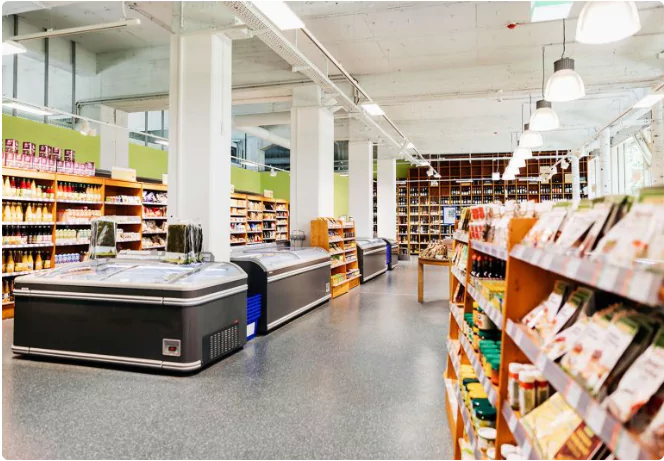The idea of storage has changed a lot throughout history to meet new needs and advancements in technology. Let’s delve into where it all began and how it has changed over time.
Origins of Icehouses
Icehouses were one of the ways to keep things cold around back, in the day! These cool structures were usually built underground or partly underwater to store ice that had been collected from lakes or rivers during the winter season. The ice was kept chilled using straw or sawdust to make sure it stayed cold when the weather got warmer. This cool trick helped people keep their food fresh and even gave them a way to stay cool at home before fancy refrigerators came along.
Transition from Natural to Mechanical Cooling
As societies advanced over time and populations grew in cities, using ice for cooling purposes became less feasible. This challenge prompted the exploration of refrigeration systems to provide more dependable and stable cooling solutions. The shift towards these systems represented a change in the way cold storage was viewed and used. Through the use of technology, it became achievable to establish controlled environments that were not reliant on the availability of ice.
What Innovations Transformed Cold Storage?
The progress of refrigeration technology has seen advancements that have reshaped its functions and uses.
Development of Refrigeration Technology
Refrigeration technology has played a role in revolutionizing cold storage practices throughout history. In the days of mechanical refrigeration systems utilizing ammonia as a refrigerant presented safety concerns despite their effectiveness. As time progressed and advancements were made in developing more efficient refrigerants have become widely embraced by various industries. Currently, cutting-edge refrigeration units are essential for ensuring temperature control for a wide range of purposes, such as food preservation and medical storage.
Emergence of Cold Rooms
Cold rooms are a version of the traditional cold storage methods used in the past that heavily depended on natural resources for preservation purposes. Unlike their predecessors, these modern cold rooms provide customized environments that cater to requirements. Equipped with temperature control systems, they guarantee ideal conditions for storing various products. For businesses in need of solutions, companies such as Create Refrigeration offer innovative choices that align with specific needs and preferences.
The Role of OEM in Cold Storage Solutions
In the changing realm of cold storage facilities, Original Equipment Manufacturers (OEMs) are key players in providing tailor-made solutions. Working together with an OEM gives companies access to machinery crafted to meet specific operational needs. This partnership guarantees that refrigerated storage spaces and cooling systems are not just effective but meet the standards and protocols of the industry.
Advancements in cold storage technology have been evolving to meet the increasing need for efficiency and reliability in preserving items across different industries.
Why Is Modern Cold Storage Essential Today?
Modern cold storage is more than about preserving things; it plays a crucial role in many areas of our daily lives today by ensuring food safety and supporting global supply chains, among other things.
Importance in Food Safety and Preservation
In today’s society, the need for safe food is crucially important. Cold storage plays a role in keeping perishable goods like fruits, dairy products, and meats at the right temperatures to avoid spoilage and contamination. This not only prolongs the freshness of the items but also preserves their nutritional content and flavor. By maintaining temperature regulations current cold storage facilities play a vital role in decreasing instances of foodborne illnesses which ultimately protects public health.
Impact on Global Supply Chains
Maintaining temperatures in storage facilities plays a crucial role in today’s interconnected supply networks worldwide as trade continues to expand globally and the demand for shipping perishable items over long distances rises steadily to preserve their quality throughout the journey from production sites to end consumers without compromise on freshness or condition due to geographical constraints. Loading…
How Do You Choose the Right Cold Storage Solution?
Opting for the cold storage solution is essential, for companies looking to enhance their efficiency and uphold the quality of their products, with various elements to consider in this process.
Factors to Consider in Design and Installation
When creating a cold storage facility design, it’s crucial to factor in elements, like optimizing space usage, enhancing energy efficiency, and ensuring scalability. The arrangement should promote operations and convenient item retrieval. Furthermore, using energy-saving technology can cut down on expenses. Help protect the environment. Considering growth is key too to meet increasing business demands without sacrificing function.
Role of OEM Solutions in Customization
Customization is key to addressing specific requirements in cold storage solutions. By collaborating with an OEM, businesses can develop tailored systems that meet unique operational demands. OEMs offer expertise in crafting equipment that aligns with industry standards and integrates seamlessly into existing infrastructures. This partnership ensures that cold storage facilities are not only efficient but also adaptable to evolving market trends.
Through careful consideration of design elements and leveraging OEM capabilities, you can create a robust cold storage solution that enhances your operational efficiency while ensuring product quality and safety across various sectors.
What Does the Future Hold for Cold Storage?
The field of refrigerated storage is always changing due to advances in technology and trends emerging. The future holds several significant developments that will impact the industry.
Emerging Trends and Technologies
In the world of refrigerated storage facilities, today’s focus is on innovation and progression stands out prominently; a key trend is the incorporation of technology (also known as the Internet of Things), enabling live monitoring and regulation of temperature settings within storage spaces, which leads to improved accuracy in maintaining ideal conditions and subsequently enhances product quality while minimizing wastage.
A notable progress is the implementation of energy-saving systems in response to growing concerns about the environment’s effects. There is a movement towards adopting methods in cold storage operations that involve investigating technologies, like solar-powered refrigeration units and improved insulation materials to reduce energy usage while ensuring effectiveness.
Additionally, the use of automation is transforming the way cold storage logistics operates. To optimize inventory management and cut down labor expenses, automated guided vehicles (AGVs) and robotics are now in use. These advancements not only boost operational effectiveness but also prioritize safety by reducing employees’ exposure to harsh temperatures.
Challenges and Opportunities Ahead
As new technologies bring opportunities to the table, they also come with obstacles that need to be overcome. One significant challenge lies in the upfront expenses linked to adopting state-of-the-art technologies. Companies need to assess these costs in comparison to the future advantages to decide if they are practical.
In a digital world where we rely more on technology solutions than ever before, it’s crucial to prioritize cybersecurity measures to safeguard vital information regarding inventory and operations against potential security breaches, to maintain smooth operations without interruptions.
Despite these difficulties, there are chances for growth in worldwide markets. The need for refrigerated storage options is on the rise as consumers expect produce all year round and pharmaceutical demands for precise temperature control increase.
By keeping up with trends and tackling issues head-on promptly, you can place your business at the cutting edge of advancements in cold storage technology, seizing chances for expansion and achievement in this ever-evolving industry.























